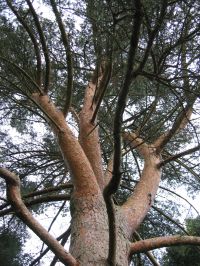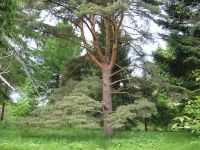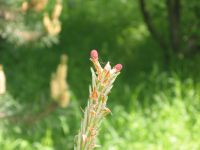Scots pine - Pinus sylvestris
English name:
Scots pine
Family:
Pinaceae (Pine family)
Height:
Up to 30 m.
Flowering:
Late May early June
Range:
From North Norway south to Turkey and Spain and from Scotland in the west through northern Eurasia almost to the Pacific Ocean
 |
 |
 |
The 60-year-old Pinus sylvestris tree in the picture can be found near the Lake road in the Arboretums collection of European conifers, in square 1407 position 1524. It is a graft from the last surviving native Scots Pine on the Danish island of Læsø
Plant description:
The genus Pinus comprises about 110 species. The greatest diversity of pines occurs in Mexico. The genus has a very broad natural range in the northern hemisphere and extends south to just cross the equator in Sumatra (Pinus merkusii). All pines are evergreen but they can be shrubs, small trees or large trees up to 55 m in height. Needles on adult trees occur on short shoots. The number of needles on the short shoots is typically two, three or five, but can be 1, 4 or even up to 8. The seeds of some pine species are eatable and have provided a significant source of food for both man and animals is some parts of the world. The wood of pines has a very high economic importance.
The Arboretums collection contains 33 different species of pines and there are 123 specimens of Pinus sylvestris. The Pinus sylvestris specimens in our collection represent a latitude range of 40 to 69 oN and a longitude range of 3 oW to 129 oE.. Large differences in growth rate occur depending upon latitude can be seen. In Norway this species reaches 71 oN making it the most northerly occurring pine.
Pinus sylvestris is a shade intolerant species and is very useful in gardens as well as in forestry. In the smaller gardens it can be trimmed in the fashion seen of Japanese gardens (some small, slow growing forms exist). In larger gardens old, irregular specimens have been used as truly dramatic focal points and as providers of moderate shade. Because it casts light shade, Scots pine is especially useful as an over-story tree to protect other plants in the garden. The orange bark in the upper part of the crown can be especially attractive.
Scots pine was once a wide spread element of the natural forests of Denmark. By about 900 years ago it had become very rare. It has now been reintroduced in many places and is thriving. The last surviving native specimen in Denmark (Bangsbofyren) occurs on the island of Læsø between Denmark and Sweden. All large pine trees on the island were cut down for the production of sea salt. One of the last surviving seedlings was dug up and re-planted it a farmyard where it has survived to this day. This last survivor provided the scion which has since developed into a handsome tree occurring in the Arboretum. (see photographs).
Needles occur in pairs. They are often twisted and blue-green in colour. The orange, flaky, bark in the upper part of the tree stem is a useful character for identification. In the Hørsholm Arboretum needle length varies from 2 to 9 cm. Latitude of the seed source (provenance) affects needle length, needles being shorter for both the most northerly and the most southerly provenances. Flowering occurs in late May to early June with lemon-yellow pollen cones and deep-red seed cones at the tips of new shoots.
References:
Farjon, A. 2001. World Checklist and Bibliography of Conifers. Royal Botanic Gardens, Kew publishers. 309 pp.
Rushforth, K. 1999. Trees of Britain and Europe. Harper Collins Publisher. Pp 1135-1136
